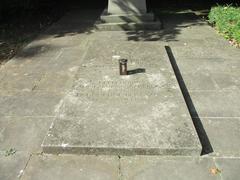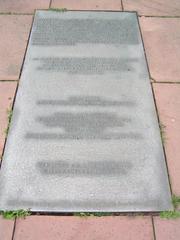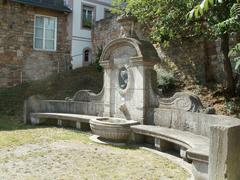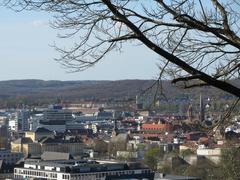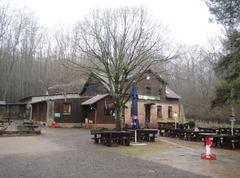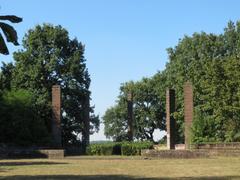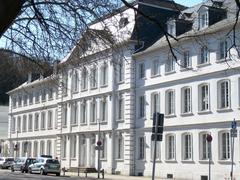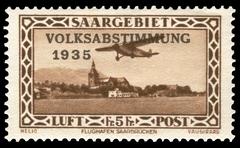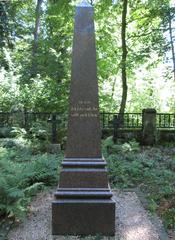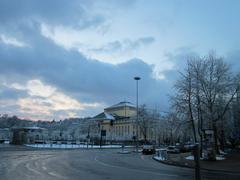
Stiftskirche St. Arnual Saarbrücken: Visiting Hours, Tickets, and Historical Significance
Date: 04/07/2025
Introduction
Stiftskirche St. Arnual, nestled in the historic St. Arnual district of Saarbrücken, Germany, stands as a beacon of religious, cultural, and architectural legacy. With origins rooted in the early medieval period, this church has witnessed over a millennium of spiritual and communal life. Archaeological findings confirm the presence of a Merovingian burial ground beneath the church, highlighting its significance as a sacred site since the 7th century. Traditionally associated with Bishop Arnual (Arnoald) of Metz, the church became a nucleus for Christianization and pilgrimage in the region (Stiftskirche St. Arnual Official Website; Wikipedia – Stift Sankt Arnual).
The current Gothic basilica, primarily constructed between the late 13th and early 14th centuries, features pointed arches, ribbed vaults, and later Baroque additions such as the iconic dome atop the west tower. This architectural evolution reflects the church’s dynamic history and the influence of French Gothic styles moving eastward (kulturkirchen.com; regionalgeschichte.net).
Throughout its existence, Stiftskirche St. Arnual has served as a spiritual center, educational hub, and burial site for local nobility. It is also a vibrant venue for art, music, and community gatherings, featuring stained glass windows by György Lehoczky and a modern Kuhn organ (Reisen ist Freiheit; stiftung-kiba.de).
This guide provides comprehensive details on the church’s rich history, architectural highlights, visiting hours, ticketing, tours, and travel tips to help visitors make the most of their experience.
Contents
- Early Origins and Foundation
- Architectural Evolution
- Cultural and Religious Significance
- Historical Highlights
- Visitor Information: Hours, Tickets, Accessibility, and Tours
- Travel Tips & Nearby Attractions
- Visuals and Media
- Frequently Asked Questions (FAQ)
- Conclusion & Recommendations
- References
Early Origins and Foundation
Stiftskirche St. Arnual’s site has been sacred since at least the 7th century, with archaeological excavations confirming a Merovingian burial ground beneath the current church (official website). The village of Merkingen, later renamed Sankt Arnual, was reputedly granted to Bishop Arnual by Merovingian King Theudebert II around 600 CE. Arnual founded a missionary center here and is believed to be buried on-site, making the church an early pilgrimage destination.
The collegiate foundation (Stift) is first documented in 1135, though possible earlier origins are hinted at by medieval seals and local noble connections. By the 10th and 12th centuries, the establishment of a clerical community and subsequent expansions signaled the site’s growing religious importance.
Architectural Evolution
The current church exemplifies early Gothic architecture in Saarland. Construction began in the late 13th century, with the eastern sections and transept completed around 1290, the west tower erected circa 1315, and the nave added by 1320 (kulturkirchen.com). The building’s cruciform ground plan and blend of French Gothic and later Baroque elements reflect both continuity and transformation.
Key Features:
- Early Gothic Elements: Pointed arches, ribbed vaults, and harmonious proportions.
- Cruciform Layout: A classic cross-shaped plan.
- West Tower: Finished in the early 14th century; the Baroque cupola was added in 1746 by architect Friedrich Joachim Stengel (touren.saarland).
- Interior Artistry: Medieval baptismal font (c. 1475), late Gothic pulpit (converted into an altar in 1888), and numerous funerary monuments.
- Modern Additions: Stained glass by György Lehoczky and a 1995 Kuhn organ.
Beneath the choir, archaeological remnants of earlier structures and Roman foundations can be seen (ev-stift-st-arnual.de). Parts of the former cloister are visible on the church’s south side.
Cultural and Religious Significance
Early Christian Foundations
The church’s association with Bishop Arnual gave rise to its role as a center of regional Christianization. The sacredness of the site is affirmed by the Merovingian burial ground and traditional accounts of Arnual’s burial here (Wikipedia – Stift Sankt Arnual; Reisen ist Freiheit).
Collegiate Chapter
By the 9th century, a collegiate chapter was established, documented in 1135 and under the Diocese of Metz. The Stift managed up to 40 parishes and operated a Latin school from 1223, laying the foundation for Saarland’s oldest grammar school, Ludwigsgymnasium Saarbrücken, in 1604.
Pilgrimage and Royal Patronage
Royal visits, such as King Louis VII of France in 1147, and recognition as a diocesan seat in 1372 highlight its importance (Wikipedia – Stift Sankt Arnual; Reisen ist Freiheit).
Burial Site
The church houses elaborate tombs of local nobility, including Elisabeth of Lorraine and Count Johann III of Nassau-Saarbrücken, underscoring its aristocratic and memorial significance.
Reformation and Protestant Heritage
In 1575, the church became Protestant and now serves the Evangelische Kirchengemeinde St. Arnual, part of the Evangelical Church in the Rhineland.
Music and Art
The church’s acoustic qualities make it a favored concert venue. The Kuhn organ (1995) and Lehoczky’s stained glass windows add modern artistic value (Reisen ist Freiheit; stiftung-kiba.de).
Historical Highlights
- 7th century: Foundation by Bishop Arnual.
- 1147: Visit by King Louis VII and crusaders.
- 13th–14th centuries: Main Gothic construction.
- 1372: Recognized as a secondary diocesan seat.
- 15th–17th centuries: Principal burial site of Nassau-Saarbrücken nobility.
- 1575: Protestant Reformation and transformation.
- 20th–21st centuries: Restoration and cultural programming (stiftung-kiba.de).
Visitor Information
Opening Hours
- Monday–Friday: 9:00 AM – 5:00 PM
- Saturday & Sunday: 10:00 AM – 6:00 PM
- Public Holidays: Check official website for updates.
Tickets & Admission
- Admission: Free; donations welcome for preservation.
- Guided Tours: Available on weekends or by appointment via the Saarbrücken tourist office or church administration.
Accessibility
- Wheelchair Access: Main entrance ramp and designated seating; accessible restrooms available (accessibility details).
- Facilities: Restrooms and assistance for visitors with disabilities.
Guided Tours & Events
- Regular Tours: Themed and family-friendly tours, including “Auf der Suche nach Grauly.”
- Special Events: Concerts, art exhibitions, and anniversary celebrations. Check the event calendar.
Photography
- Photography is generally permitted; avoid flash and respect services and artworks.
Travel Tips & Nearby Attractions
- Getting There: 15-minute walk from Saarbrücken city center; bus stop “St. Arnualer Markt” nearby; limited parking.
- Nearby Sites: Saarbrücken Castle, Ludwigskirche, Saarland Museum, historic St. Arnualer Markt.
- Amenities: Cafes, bakeries, and shops in the district.
- Dress Code: Modest attire recommended, especially during services.
- Language: Tours primarily in German; some English and French materials.
- Contact: +49 (0)681 523 42 / [email protected]
Visuals and Media
- Official Photo Gallery
- Virtual tours and maps available on the official website.
Frequently Asked Questions (FAQ)
Q: What are the visiting hours?
A: Monday–Friday 9:00 AM–5:00 PM, weekends 10:00 AM–6:00 PM; check here for updates.
Q: Is there an entrance fee?
A: Admission is free; donations are appreciated.
Q: Are guided tours offered?
A: Yes, on weekends and by prior arrangement.
Q: Is the church wheelchair accessible?
A: Yes, with ramps and accessible facilities.
Q: Can I attend concerts?
A: Yes, regular concerts and events are hosted; see the event calendar.
Q: Can I take photographs?
A: Yes, except during services and near sensitive artworks.
Conclusion & Recommendations
Stiftskirche St. Arnual exemplifies the enduring legacy of Saarbrücken’s religious, artistic, and communal spirit. Its blend of medieval architecture, noble tombs, vibrant art, and active community life makes it an unmissable landmark. Visitors are encouraged to plan ahead, utilize guided tours, and participate in events for a deeper appreciation of this unique site.
For real-time information, event schedules, and audio guides, download the Audiala app or follow the church on social media. Explore other nearby historical attractions to experience the full richness of Saarbrücken’s heritage.
References
- Stiftskirche St. Arnual Official Website
- Regionalgeschichte.net – Stiftskirche St. Arnual
- Reisen ist Freiheit – Stiftskirche St. Arnual
- Stiftskirche St. Arnual Visitor Information
- Stiftung KiBa – Restoration Projects
- Touren Saarland – Stiftskirche St. Arnual
- Wikipedia – Stift Sankt Arnual







































